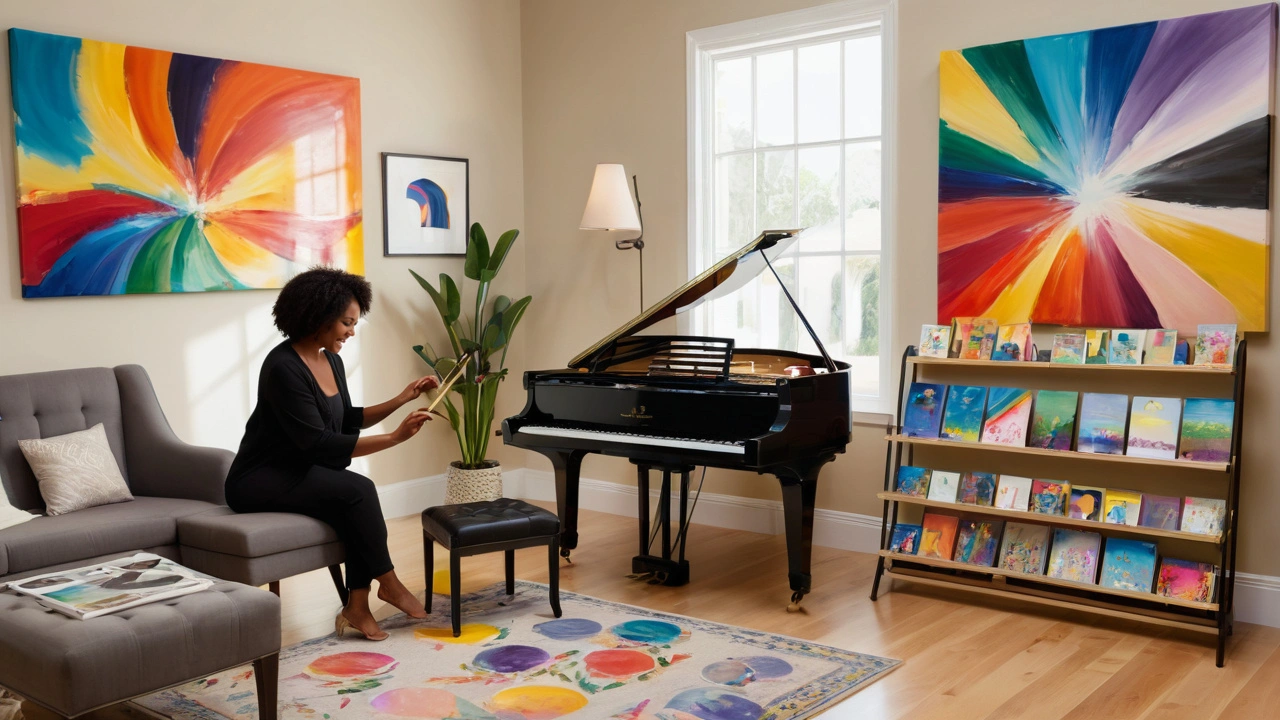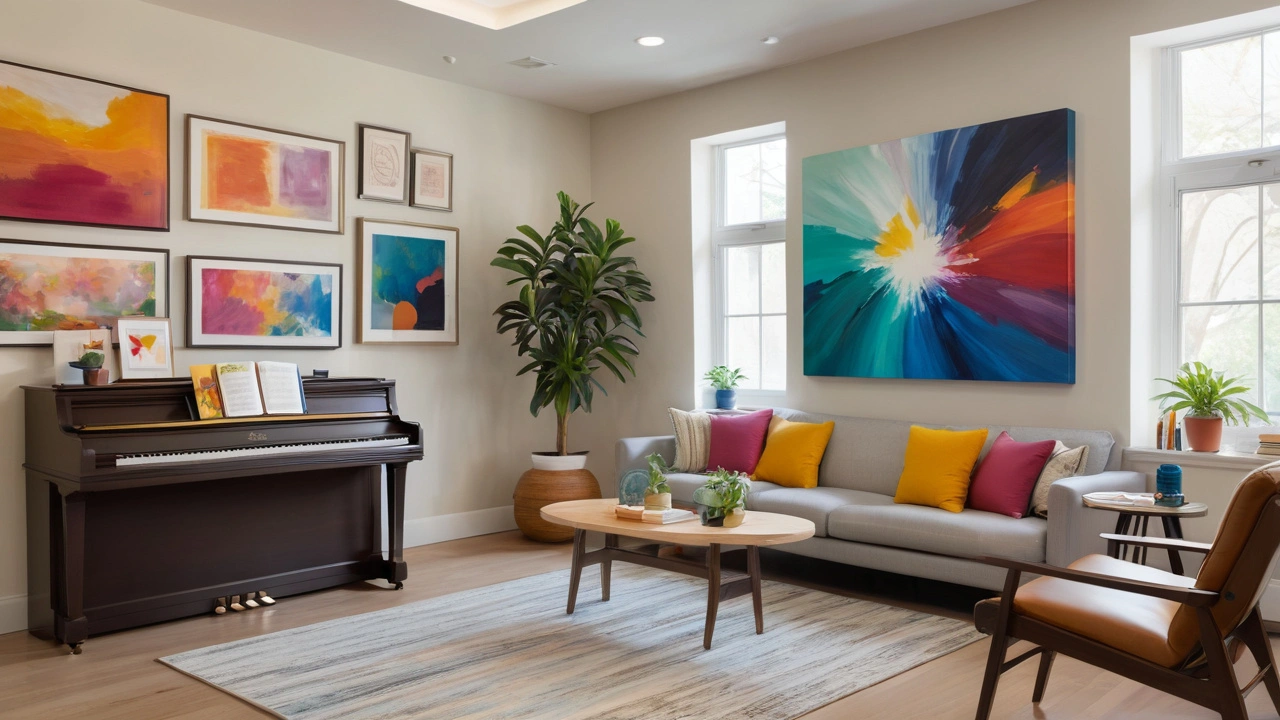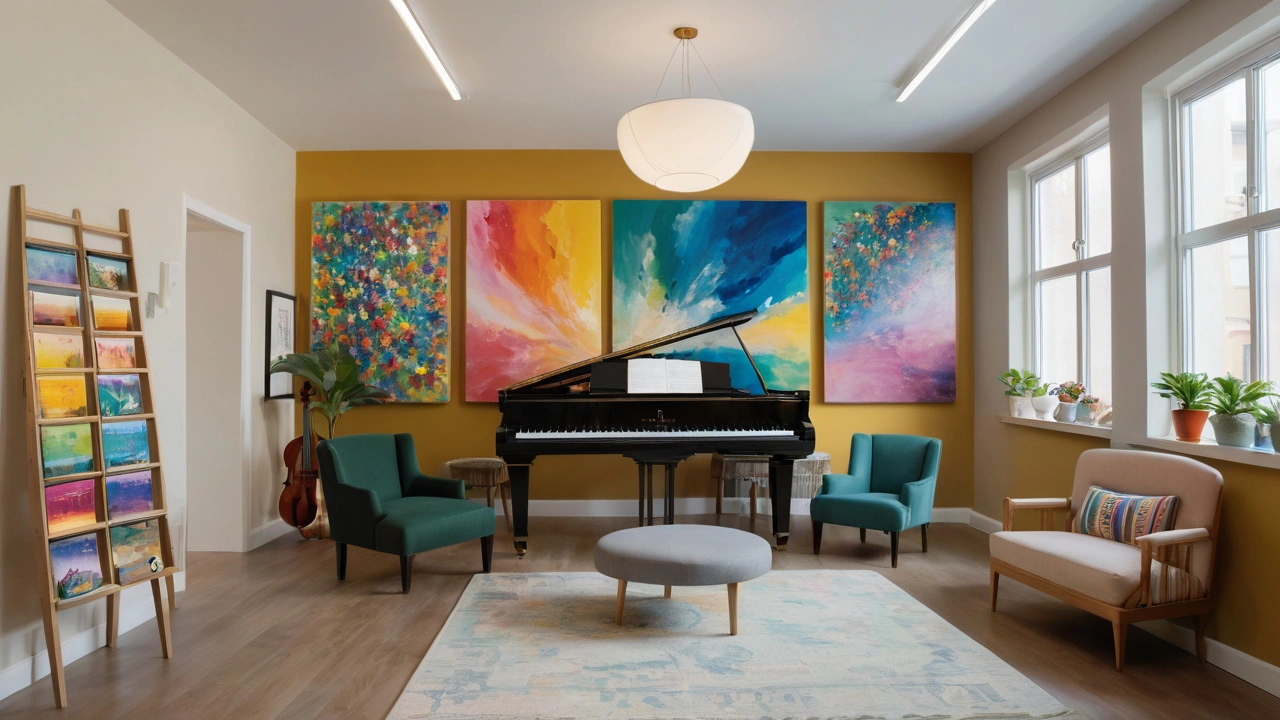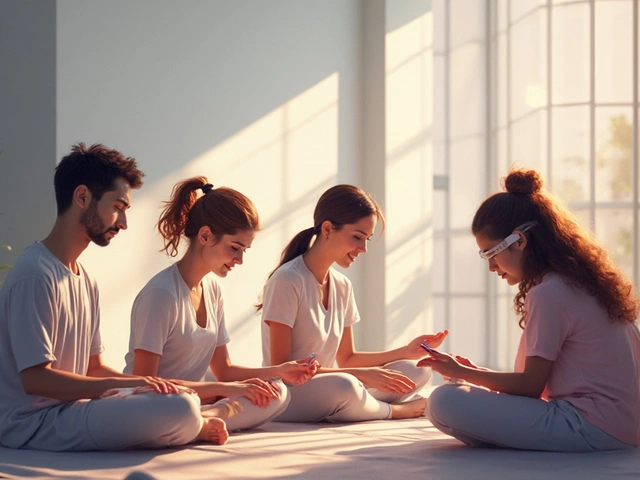Creative Arts Therapies have emerged as a unique and effective means of addressing mental and emotional health. By leveraging the intrinsic power of artistic expression, these therapies offer a refreshing departure from traditional methods.
From painting and music to dance and drama, the various forms of creative arts therapy cater to diverse preferences and needs. They provide a safe space for individuals to explore their feelings, manage stress, and foster personal growth in a non-verbal and non-invasive manner.
- Introduction to Creative Arts Therapies
- Types of Creative Arts Therapies
- Benefits of Creative Arts Therapies
- Scientific Support for Creative Arts Therapies
- Implementing Creative Arts Therapies in Daily Life
- Success Stories & Case Studies
Introduction to Creative Arts Therapies
Creative Arts Therapies encompass a range of modalities which use artistic processes to aid in psychological healing and personal growth. It’s a field that looks past the conventional idea of therapy and taps into the power within art. The notion here is that everyone carries an innate ability to be creative, and by nurturing this creativity, emotional and mental well-being can be significantly enhanced.
One might wonder why art? The answer lies in its ability to allow expression when words fall short. Art has this beautiful unspoken language that helps convey emotions, experiences, and thoughts which might be too complex or painful to verbalize. As Pablo Picasso eloquently put it, “Art washes away from the soul the dust of everyday life.” Through the process of creating, individuals can find solace, relief, and a sense of achievement.
The origins of Creative Arts Therapies can be traced back to the mid-20th century. Initially emerging as a structured field within healthcare, it drew from the insights of psychology, education, and the arts. It’s not about creating art with an intention to produce a masterpiece, but about the therapeutic process and personal reflection that takes place during creation.
In recent years, research has supported the effectiveness of these therapies across various populations – from children with autism to adults dealing with trauma or chronic illness. Studies highlight that engaging in art therapy activities can lead to lower levels of anxiety, stress, and depression. For instance, a study published in the Journal of the American Art Therapy Association indicated that participants who engaged in just 45 minutes of creative activity experienced a significant reduction in stress hormones.
There are different categories within Creative Arts Therapies, each utilizing a specific form of art to promote healing. Art Therapy involves visual arts like drawing or painting; Music Therapy employs music creation or listening; Dance/Movement Therapy uses movement and dance; and Drama Therapy taps into acting and role play. Each of these therapies creates different pathways for individuals to explore and express their inner-world.
“Art therapy can be an effective way of thinking outside the box and working through emotional obstacles, helping people find new perspectives,” says Dr. Cathy Malchiodi, a leading figure in the field of art therapy.
The beauty of Creative Arts Therapies lies in its flexibility and adaptability. Whether conducted in group settings or individually, in hospitals, schools, or private clinics, they can be tailored to fit the unique needs and preferences of different individuals. This makes them especially effective for those who might find it difficult to engage in traditional talk therapies.
Types of Creative Arts Therapies
Creative arts therapies encompass a broad range of expressive practices that cater to different needs and preferences. By engaging in these activities, individuals can explore their feelings, manage distress, and communicate in ways that might be difficult with words alone. Let's delve into some of the common types of creative arts therapies and their unique contributions to mental health.
Art Therapy
Art therapy uses visual art practices like painting, drawing, and sculpting to help individuals express themselves and gain insights about their emotions and behaviors. This form of therapy doesn't require any artistic skills, making it accessible to anyone. According to the American Art Therapy Association, art therapy can help reduce anxiety, improve emotional resilience, and boost self-esteem.
"Art can permeate the very deepest part of us, where no words exist." – Eileen Miller, Expressive Arts Therapist
Art therapists often work in settings ranging from hospitals to schools and private practices. During a session, therapists may provide prompts or allow free expression, depending on the therapeutic goals. The process of creating art itself can be tremendously soothing and enlightening.
Music Therapy
Music therapy involves using music to promote emotional well-being and enhance the quality of life. Participants might engage in activities such as singing, playing instruments, composing music, or simply listening. Music therapy has been shown to alleviate symptoms in a variety of contexts, including chronic pain management, rehabilitation, and mental health treatment.
A study published in the Journal of Music Therapy found that music therapy significantly reduced levels of anxiety and depression in patients undergoing cancer treatment. This type of therapy is versatile and can be tailored to fit individual needs, from structured sessions to more spontaneous musical engagement.
Dance/Movement Therapy
Dance/movement therapy uses the body’s movements as a way to achieve emotional, cognitive, and physical integration. Originating from modern dance principles, this therapy enhances social, emotional, and mental health through movement. It is based on the premise that the mind and body are interconnected.
The American Dance Therapy Association notes that dance therapy is effective for a wide array of populations, from children to the elderly, and is particularly beneficial for those with PTSD, eating disorders, and chronic illnesses. Sessions can range from highly structured exercises to freeform dance, guided by the therapist to meet the individual’s needs.
Dramatherapy
Dramatherapy uses techniques from theater to help individuals express themselves and solve personal challenges. This therapy can involve role-playing, script work, and improvisation, allowing participants to explore their emotions and behaviors in a safe and controlled environment.
Dramatherapists work in a variety of settings, including mental health facilities and schools. They help individuals tap into their creative side to uncover insights and develop coping strategies. This form of therapy is particularly effective for those dealing with trauma, anxiety, and social challenges.
Expressive Writing Therapy
Expressive writing therapy encourages individuals to write about their experiences, thoughts, and feelings as a way to process and heal. Writing can help clarify thoughts, reduce stress, and improve mental well-being. Techniques might include journaling, poetry, or narrative writing.
A study in the Journal of Health Psychology revealed that participants who engaged in expressive writing experienced significant improvements in mood and physical health. This therapy is flexible and can easily be incorporated into daily routines, making it accessible to a wide audience.
The variety within creative arts therapies means that there is likely an approach that resonates with every individual. These therapies provide powerful tools for self-exploration and healing, transcending the limits of traditional talk therapies.

Benefits of Creative Arts Therapies
Creative Arts Therapies offer a range of benefits that substantially enhance mental and emotional well-being. These therapies harness the power of creative expression to foster healing, provide emotional release, and improve psychological resilience.
One key benefit of creative arts therapies is their ability to address trauma in non-verbal ways. Many individuals find it challenging to articulate their traumatic experiences through words alone. Engaging in activities such as painting or dance allows them to express their pain and heal over time. This non-verbal communication can be especially beneficial for children and individuals who have difficulty talking about their emotions.
Another significant advantage is the reduction of stress and anxiety. Creative arts therapies such as music therapy have been shown to lower cortisol levels, the body's primary stress hormone. Through rhythmic activities and listening to soothing compositions, individuals can achieve a state of relaxation that promotes mental equilibrium. Art therapy, on the other hand, offers a calming effect through the tactile and visual elements of creating art.
Moreover, creative arts therapies enhance cognitive function and improve concentration. Activities like drawing and drama require focus, problem-solving skills, and planning. They engage different areas of the brain, leading to improved cognitive abilities. In schools, incorporating creative arts into the curriculum has shown to boost students' academic performance and engagement.
These therapies also foster social connections and reduce feelings of isolation. Group music therapy sessions, for example, allow individuals to connect with others through shared musical experiences. This sense of community and mutual support can be particularly beneficial for individuals dealing with depression or social anxiety. Art therapy groups similarly provide a platform for participants to share and discuss their creations, fostering empathy and understanding.
Additionally, creative arts therapies offer a unique form of emotional self-regulation. Engaging in creative activities helps individuals channel their emotions into productive outlets. This can lead to improved mood and emotional stability. For instance, using art to express anger or frustration can be a healthier alternative to destructive behaviors.
"Creative arts therapies enable individuals to access emotions that are often hidden or suppressed," explains Dr. Cathy Malchiodi, a leading expert in art therapy. "They provide a safe and structured space for self-exploration and emotional expression."
Finally, the transformative power of creative arts therapies lies in their ability to build self-esteem and confidence. Completing an artwork or performing a dance piece can provide a sense of accomplishment and pride. It validates the individual's effort and creativity, which can significantly boost their self-worth.
In summary, the benefits of creative arts therapies are manifold. By promoting non-verbal expression, reducing stress, enhancing cognitive function, fostering social connections, aiding emotional regulation, and building self-esteem, these therapies are proving to be a game-changer in therapeutic practice.
Scientific Support for Creative Arts Therapies
Delving into the world of Creative Arts Therapies reveals a growing body of research that substantiates their effectiveness in enhancing mental and emotional health. Studies consistently demonstrate that engaging in creative activities such as painting, drawing, music, and dance can significantly reduce symptoms of anxiety and depression. For instance, a notable study published in the Journal of the American Art Therapy Association found that just 45 minutes of art creation can reduce levels of the stress hormone cortisol in the body.
Music therapy, in particular, shows remarkable promise. Research published in the British Journal of Psychiatry indicates that music therapy can alleviate symptoms in patients with severe depression and improve their quality of life. The mechanisms behind this are thought to involve music's ability to engage the brain's reward and pleasure centers, thereby promoting emotional well-being and relaxation.
Benefits of Dance and Movement Therapy
On the other hand, dance and movement therapy have been extensively studied for their physical and psychological benefits. A 2019 study from the American Journal of Dance Therapy demonstrated that patients with Parkinson's disease showed improved motor function and reduced symptoms of depression after participating in regular dance therapy sessions. This therapy works by combining physical movement with emotional expression, fostering a mind-body connection that is particularly beneficial for those with chronic illnesses.
"The evidence for the efficacy of Creative Arts Therapies is compelling, particularly for conditions that traditional therapies struggle to address," says Dr. Jane Edwards, a leading researcher in the field.
Creative Arts Therapies are also used in trauma recovery. Artwork allows trauma survivors to express feelings they cannot put into words and gain a sense of control over their recovery process. Studies have shown that engaging in artistic activities can help integrate traumatic memories and reduce flashbacks.
Current Data on Creative Arts Therapies
The benefits are not just anecdotal; they are backed by data. A 2021 meta-analysis reviewing 40 studies on creative arts therapies found that these interventions significantly improved psychological outcomes across diverse populations. The following table summarizes some key findings:
| Therapy Type | Reduction in Symptoms |
|---|---|
| Art Therapy | 30% decrease in anxiety levels |
| Music Therapy | 25% improvement in mood |
| Dance Therapy | 50% improvement in motor skills (Parkinson’s patients) |
These findings highlight how creative arts therapies are not merely supplementary treatments but integral components of a comprehensive approach to mental health therapy. By continuing to explore and validate their benefits through scientific research, the therapeutic community can broaden the accessibility and application of these transformative practices.

Implementing Creative Arts Therapies in Daily Life
Integrating creative arts therapies into your daily routine can have a transformative impact on both your mental and emotional well-being. It's not just about tapping into your artistic side, but about allowing yourself to explore feelings and situations creatively. You don’t need to be a professional artist or musician to benefit from these therapies; the focus is on expression, not perfection.
Start Simple with Drawing or Painting
One of the easiest ways to start is by setting aside some time each day to draw or paint. You could use a sketchbook or a simple watercolor set. It's often suggested to begin with basic shapes or abstract forms, which can be less intimidating. The important thing is to allow your mind to wander and let the brush or pencil flow freely. This can be particularly effective in the evening, helping to unwind and process the day’s events.
Incorporating Music and Movement
Music and dance are other powerful tools. Create a playlist of songs that you find uplifting, calming, or evocative, and let yourself move to the music. You don’t need to follow any specific dance steps. Let your body guide you. Incorporating just 15 minutes of free dance into your daily routine can be incredibly freeing and grounding. Some people find that playing an instrument, even if only drumming on a table, is another excellent outlet for emotions. According to a study from the American Music Therapy Association, music therapy has been shown to reduce stress and anxiety while improving mood and cognitive function.
Writing and Storytelling
Journaling is an easily accessible form of creative arts therapy. Setting aside time each day to write about your thoughts and feelings can be very cathartic. You might also try your hand at storytelling, whether it's writing short stories, poems, or even scripts. The key is to express yourself freely without worrying about grammar or structure. Keeping a ‘gratitude journal’ where you note down things you’re thankful for can also shift your mindset positively over time. As noted by James W. Pennebaker, a psychologist and expert in expressive writing, consistent journaling has been linked to stronger immune function and better mental health.
Crafting and Hands-On Projects
Engaging in hands-on crafts like knitting, pottery, or collage work can be another avenue for integrating creative arts therapies into your daily life. The repetitive, tactile nature of these activities can be very soothing. Setting small, achievable goals for yourself in these projects can also provide a sense of accomplishment and boost your self-esteem.
Social Connection and Group Activities
Joining a local art class, online group, or even organizing creative get-togethers with friends can add a social dimension to your creative therapy practice. Sharing your work with others and seeing their creations fosters a sense of community and belonging. This social aspect can contribute to improved mental health and emotional resilience.
By taking small steps to incorporate different forms of creative arts therapies into your daily life, you can create a tapestry of activities that boost your emotional and mental health. Remember, the goal is personal expression and well-being, not artistic mastery.
Success Stories & Case Studies
Creative Arts Therapies have numerous success stories that highlight their profound impact on individuals' mental and emotional well-being. One well-documented case is that of Sarah, a teenager who struggled with severe anxiety and depression. Traditional talk therapy offered little progress, but she found solace and healing through art therapy. Her therapist encouraged her to express her emotions through watercolor painting, providing a safe outlet for her feelings. Over time, Sarah's artwork transitioned from dark, chaotic images to more colorful and organized compositions, reflecting her journey from turmoil towards inner peace.
Another compelling example is the use of music therapy for veterans coping with PTSD. One particular group, comprising former soldiers, participated in weekly music sessions where they could play instruments and compose songs about their experiences. The rhythmic aspect of drumming helped some release pent-up aggression, while others found comfort in the collective harmony of the group. Research has shown that music therapy can significantly reduce PTSD symptoms, highlighting its value.
"Artistic expression allows individuals to tap into their subconscious and process emotions that might be difficult to articulate verbally," says Dr. Amanda Chastain, a leading researcher in creative arts therapies.
In schools, dance therapy has proven beneficial for children with autism. Take the case of Jack, a young boy who struggled with social interaction and communication. Dance therapy sessions helped him develop better coordination and express himself through movement. Performing repetitive dance routines gave Jack a sense of structure, while improvisation aspects encouraged him to be more flexible and adaptive. Studies confirm that dance therapy enhances social skills, emotional regulation, and cognitive abilities in children with autism.
Drama therapy also shines in prison rehabilitation programs. Inmates participating in these programs report increased self-awareness and empathy. One noted case involves a group of inmates who collaboratively wrote and performed a play about their life stories. This activity not only provided an emotional release but also fostered a sense of community and responsibility. The inmates learned to trust one another and work together, skills that are crucial for life outside prison. According to a report by the American Psychological Association, drama therapy can reduce recidivism rates and improve inmates' psychological well-being.
Here's a small glimpse of how creative arts therapies transform lives:
| Case | Therapy | Outcome |
|---|---|---|
| Sarah | Art Therapy | Reduced Anxiety and Depression |
| Veterans Group | Music Therapy | Reduced PTSD Symptoms |
| Jack | Dance Therapy | Improved Social Skills |
| Inmates | Drama Therapy | Increased Self-Awareness |
These success stories and case studies underscore the transformative power of creative arts therapies. They offer hope and a way forward for those struggling with mental health issues, providing unique and effective pathways to healing.







